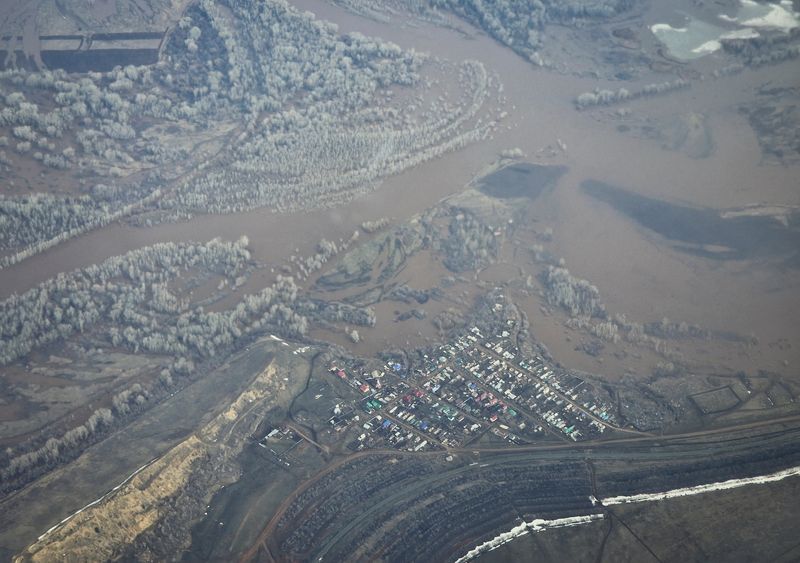By Guy Faulconbridge, Olzhas Auyezov
MOSCOW/ALMATY (Reuters) – Here is a summary of the impact of record floods that have submerged large areas of Russia and Kazakhstan:
WHICH AREAS ARE AFFECTED?
The hardest-hit areas in Russia are just south of the Ural Mountains, about 1,200 km (750 miles) east of Moscow.
Emergencies have been declared in the Orenburg and Kurgan regions in the Urals and in the Tyumen region of western Siberia, which is the largest hydrocarbon basin in the world.
The Ural River, which rises in the Ural Mountains and flows through Kazakhstan into the Caspian Sea, breached dams in the Ural city of Orsk on April 5 and flooded parts of the city of Orenburg.
Some regions around the Volga, Europe’s longest river, were flooded, as was the Altai region in Siberia. Water levels were also rising in the Tom River in the Tomsk region of Siberia.
At least 12,000 people are reported to have been evacuated in Russia. Officials increased supplies of bottled water and hepatitis A vaccinations were carried out in flooded areas.
In Kazakhstan, more than 97,000 people were evacuated. The most affected areas mostly border Russia and are crossed by rivers flowing to or from Russia: Atyrau, Aktobe, Akmola, Kostanai, East Kazakhstan, North Kazakhstan and Pavlodar regions.
The Ural flows through Atyrau, an important Kazakh oil center, where the authorities have closed schools and mobilized thousands of people to reinforce the river banks and build dams.
Kazakhstan evacuated a number of villages along the Ishim, a tributary of the Irtysh, which together with its parent Ob, forms the seventh-longest river system in the world. Authorities expect flooding in the Ishim and another tributary, the Tobol, to peak by April 23-25.
Water levels are expected to reach their peak near the city of Patpavlovsk, in the center of the North Kazakhstan region, on Thursday or Friday.
WHAT ARE THE ECONOMIC RISKS?
– Some of the flooding occurred in major grain-producing areas of Russia, the world’s largest grain exporter.
– Russia is also the second largest oil exporter in the world. The Orsk oil refinery in the Urals declared force majeure on fuel supplies from April 8, according to a document released by plant owner Forteinvest and seen by Reuters.
The plant was closed to avoid ecological risks and ensure workplace safety. Last year the refinery processed 4.5 million tons (90,000 barrels per day) of oil.
– Over 8,000 farm animals have been killed by floods in Kazakhstan and a special team has been sent by the Ministry of Agriculture to dispose of the bodies and prevent the spread of diseases.
– Hundreds of trucks carrying goods were stranded in Kazakhstan due to the closure of roads damaged or threatened by floods.
WHY ARE FLOODS SO HARMFUL?
Spring floods are a part of life across the region as harsh winter snows melt, swelling some of the mighty rivers of Russia and Central Asia. This year, however, a combination of factors has resulted in unusually severe flooding.
Russian emergency officials said the ground was waterlogged before winter and then frozen under heavy snows that then melted very quickly due to rapidly rising spring temperatures and heavy rains.
Maria Shahgedanova, professor of climate science at the University of Reading, said wet ground during the winter, heavier snowfall than usual and a rapid rise in temperature in early spring explained the extent of the flooding.
“In just a few days the temperatures went from zero to 17, 18 and even 20 degrees Celsius. And that’s what caused the snow to melt very, very quickly,” he said.
While heavy snow accumulation this winter is part of normal climate variability, he said climate change is leading to heavier snowfall in the north and east of the river region, which will likely cause more spring flooding as the snows settle. they will dissolve.
“We’re looking at a 7% increase in (snow) precipitation where there’s a one-degree temperature change,” he said.
Russia is by far the world’s largest country by area, about the size of the United States and Australia combined. Russia’s boreal forests, or taiga, cover an area nearly the same as that of the United States and are the largest forested areas on earth, so they play a crucial role in the world’s climate.
In 2009 research commissioned by the US National Intelligence Council on the impact of climate change on Russia through 2030, the authors stated that rising temperatures would lead to a series of complex problems for Russia.

These include the increased frequency of extreme weather events, including heavy rains, fires in Siberian peat bogs, and more frequent flooding of Russian Arctic rivers due to heavy rains and earlier breakup of river ice.
The document states that by 2015 there will probably be more floods in the river basins of the Archangel region, the Komi Republic, the Ural area and the Yenisei and Lena basins.